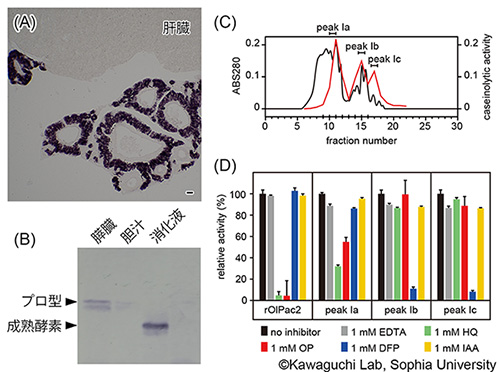Fishes have their own digestive system
Discovery of the novel digestive enzyme "pactacin"
Mammals, including humans, have stomachs and digest proteins by pepsin, synthesized in the stomach. The stomach is one of the important digestive organs for mammals. On the other hand, in teleosts, some fish have a stomach, but some do not. former are called gastric fish and the latter are called agastric fish. Gastric fish, like mammals, use pepsin as a digestive enzyme. On the other hand, agastric fishes do not possess pepsin, and use trypsin and chymotrypsin. In addition to trypsin and chymotrypsin, we found another protease that is used as a digestive enzyme in teleosts and named it pactacin (pancreatic astacin).
Various genes encoding the astacin metalloprotease family have been found in fish due to gene duplication. They are hatching enzymes to digest egg envelopes at the time of hatching, nephrosin is involved in the immune system, etc. In addition, in 2006, we found another type of astacin metalloprotease from medaka, one of an agastric fish, but its function has been unknown. In this paper, in addition to medaka, we also found the gene orthologs in seahorses, agastric fish. named pactacin (pancreatic astacin). Furthermore, we purified pactacin from the digestive fluid of medaka and clarified that pactacin, in addition to trypsin and chymotrypsin, is secreted as a major digestive enzyme in the digestive fluid.
The earth has vast bodies of water such as seas and rivers, and the fish that inhabit them are the largest and most diverse group of vertebrates. their own digestive enzymes.

Fig. (A) The seahorse pactacin gene is expressed in the pancreas. (B) Western blotting analysis of medaka pactacin (OlPac2). The pro-enzyme was detected in the pancreas, and the mature enzyme was detected in the digestive fluid. (C) Partial purification of medaka digestive fluid using HPLC. The black line indicates the protein concentration, and the red line indicates the enzyme activity. Three active peakas were observed and named peaks Ia, Ib, and Ic. (D) The activity of recombinant pactacin (rOlPac2) and the three activity peaks were examined in the presence of inhibitors for either metalloprotease, serine protease, or cysteine protease. It can be seen that the activity of recombinant pactacin is inhibited only by metalloprotease. Peak Ia is considered to be a metalloprotease (pactacin), and Ib and Ic are considered to be cysteine proteases (trypsin and chymotrypsin).
Original Paper
- Mari Kawaguchi, Yohei Okazawa, Aiko Imafuku, Yuko Nakano, Risa Shimizu, Reiji Ishizuka, Tianlong Jiang, Tatsuki Nagasawa, Junya Hiroi, and Shigeki Yasumasu. (2021) Pactacin is a novel digestive enzyme in teleosts. Scientific Reports, 11: 7230.
DOI: 10.1038/s41598-021-86565-9 - Mari Kawaguchi, Shigeki Yasumasu, Junya Hiroi,
Kiyoshi Naruse, Masayuki Inoue and Ichiro Iuchi, 2006.
Evolution of teleostean hatching enzyme genes and their paralogous genes.
Development Genes and Evolution, 216: 769-784.
DOI: 10.1007/s00427-006-0104-5